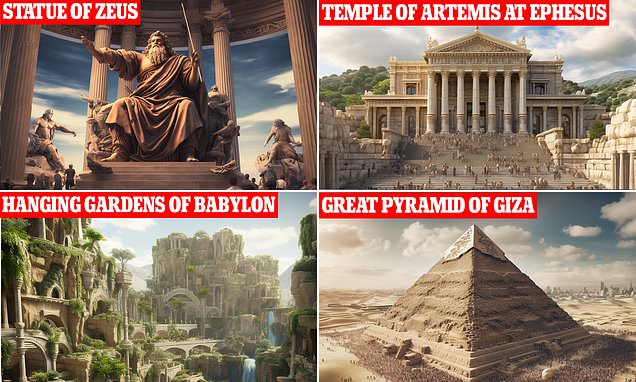Picture the ancient wonders of the world such as the Colossus of Rhodes, the Statue of Zeus, and others, restored to their former glory amidst a modern setting where bustling visitors capture moments with their smartphones. Thanks to artificial intelligence, these architectural marvels have been brought back to life, offering a glimpse into the past.
Out of the original Seven Wonders, only one remains standing today, while the rest have succumbed to the ravages of time, including warfare, societal decline, and natural calamities. However, with the aid of the innovative Midjourney imagine engine, AI has resurrected these wonders, allowing the world to marvel at their grandeur once more.
The Colossus of Rhodes

This monumental statue, towering 100 feet above the port of Rhodes, was a remarkable display of ancient engineering and craftsmanship. Constructed over a span of 12 years, the colossal figure was crafted from bronze panels and featured the likeness of Helios, the Greek sun god. Although historical depictions show the Colossus straddling the harbor entrance, modern research suggests this portrayal may not have been feasible. Instead, Helios likely stood at the harbor’s edge, welcoming passing ships.
Completed in 282 BC, the Colossus of Rhodes stood for less than a century before being toppled by a powerful earthquake.
The Great Pyramid of Giza

Situated in Egypt, the Great Pyramid of Giza is the sole surviving wonder of the ancient world and continues to attract throngs of tourists from across the globe. Built by ancient Egyptians over a span of 20 years, the pyramid’s construction involved the placement of massive stones, some weighing as much as 2.5 tons, which were transported by slaves under the command of Khufu.
Through AI reconstruction, the Great Pyramid now gleams with pristine white marble, a stark contrast to its current weathered appearance.
The Hanging Gardens of Babylon

Legend has it that the Hanging Gardens of Babylon were a marvel of ancient engineering, boasting elaborate terraces, intricate water features, and verdant flora that appeared to float in midair. However, historical accounts remain the only evidence of this lush oasis’s existence. According to tales, King Nebuchadnezzar II of Babylon commissioned the gardens for his wife, Queen Amyitis, in present-day Iraq, approximately 50 miles north of Baghdad.
Despite the absence of direct mentions in the writings of the Babylonian royal family, these legendary gardens, purportedly constructed around 600 BC, were said to feature towering hillsides reaching up to 65 feet. If they did exist, the gardens met their demise in 539 BC when the Achaemenid Empire conquered Babylon.
The Statue of Zeus at Olympia

Commissioned in Olympia as a symbol of prestige and competition against Athens, the Statue of Zeus once stood as a 40-foot-tall marvel, depicting the king of the gods seated on a throne within an open-air shrine. In a modern reimagining by AI, tourists now flock around the colossal figure, capturing its grandeur on their devices.
Historical records indicate that the magnificent statue met its tragic end in a fire that ravaged Constantinople in 426 AD.
The Lighthouse of Alexandria

Situated on Pharos Island in Alexandria Harbor, the Lighthouse of Alexandria once soared over 350 feet into the sky, serving as a beacon of knowledge and innovation in ancient Egypt. Designed by Sostratus of Cnidus, this architectural wonder showcased the advanced scientific and mathematical prowess of Alexandria, the philosophical capital of its time.
Despite its grandeur, the lighthouse fell into disrepair and eventual ruin during the Middle Ages, succumbing to the forces of nature after enduring multiple earthquakes.
The Mausoleum at Halicarnassus

Constructed in honor of Mausolus, the king of Caria in ancient Asia Minor, the Mausoleum at Halicarnassus was a monumental tribute that inspired the term “mausoleum” for grand funerary structures. Crafted from Anatolian and Pentelic marble, this architectural masterpiece blended elements of Greek, Near Eastern, and Iranian architectural styles.
When the tomb was excavated, remnants of sacrificial offerings, including oxen, sheep, and birds, were discovered, suggesting elaborate send-off rituals for the mausoleum’s intended occupant. Erected in 350 BC in present-day Turkey, the mausoleum met its demise in the 13th century due to a series of catastrophic events.
The Temple of Artemis at Ephesus

Dedicated to Artemis, the Greek goddess of chastity, hunting, wildlife, forests, and fertility, the Temple of Artemis in Ephesus faced destruction and reconstruction multiple times throughout history. Initially set ablaze by Herostratus in a quest for infamy, the temple later fell victim to the ravages of the Goths as they passed through the region en route to evade Roman forces.
The final blow came in 401 AD when a Christian mob razed the temple to the ground, leaving behind only its foundations and a solitary column as poignant reminders of its former glory.






